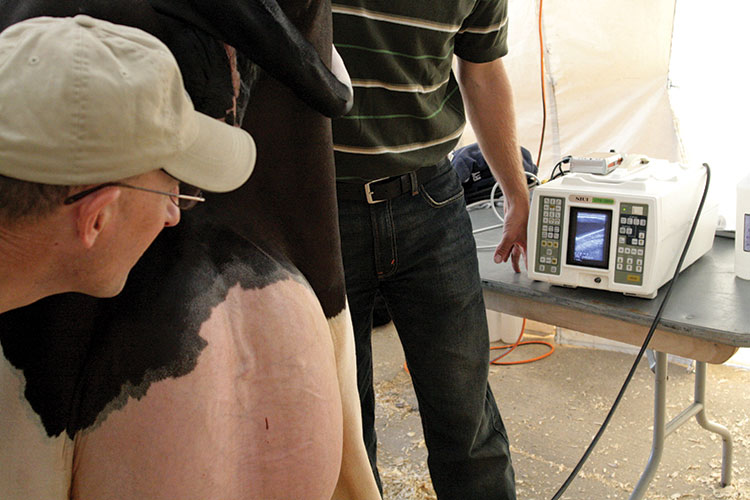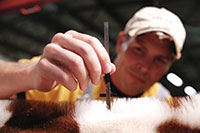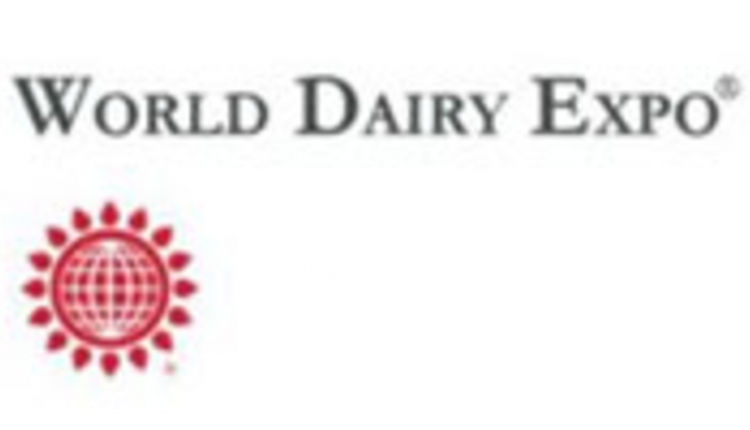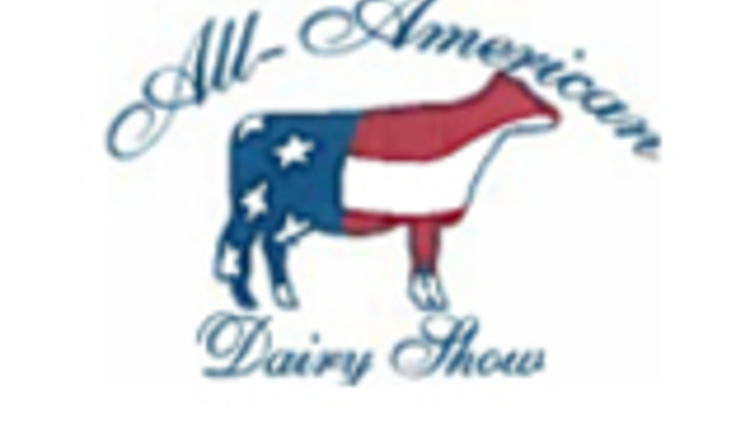
A level playing field for all exhibitors and, more importantly, the fact that milk and beef are food for human consumption were the two primary reasons World Dairy Expo leaders forged ahead with pioneering efforts to clean up its cow show when “udder fixing” spun out of control by the mid-1990s. Following seven years of careful study backed by a number of peer-reviewed scientific research trials in the areas of milk sampling and ultrasound, show management fully implemented the plan at the 2002 show.
Would the plan work?
Would exhibitors still come to the show?
Those were the questions going into 2002.
The clarity of history tells us, “Yes, it worked.” But in 2002, the answers to those questions were in doubt. “Leaders like Greg Blaska and Roger Ripley held firm when others wavered,” recalled Dave Selner, who was in the middle of the seismic shift that created the “World Dairy Expo Showring Code of Ethics” used to this very day.
Prior to the start of the 2002 show, some people thought entries would be down due to the ultrasound testing requirements and other surveillance efforts. Some people even threatened to boycott the show. However, the opposite seemed to happen — exhibitors responded by bringing more cattle. The net result was that animals going through the ring that year were up 11% compared to 2001.
While the first research on running milk samples and ultrasound tests trace back to efforts in 1997, one could say that the project really started at the show’s very beginning in 1967 and got a significant boost with the opening of the University of Wisconsin School of Veterinary Medicine in 1983.
The mindset was present, but science needed to catch up. So did the Purebred Dairy Cattle Association (PDCA) Code of Ethics.
“In those days, PDCA’s Code of Ethics was very punitive and had very harsh forms of punishment. Therefore, few shows followed those written rules as they were too difficult to enforce and were full of legal jeopardy,” explained Selner, who served as vice chair and then chair of World Dairy Expo’s Dairy Cattle Exhibitor Committee in that era of transformation.
The early days

“I believe the overriding goal was to find ways to eliminate these practices from shows from an animal welfare standpoint and to level the playing field for all exhibitors. Dad also believed more people would exhibit at a clean show,” said his oldest son, Roy Hetts.
World Dairy Expo was one of the first shows, if not the first, to require top-placing cows to be milked out before the final placings and reasons were given by the judge. The milkout requirement had strong backers in the early days. However, support was not unanimous as there were drawbacks — the milkout caused the show to drag on, cows had to be rebagged for photos the next day, and Grand and Reserve Grand Champions were photographed in the showring with empty udders.
Eventually, a milkout of the top cows in each class became the judge’s option. From that point, the milkout slowly faded into the history books. With its sunset, “creativity” in cow preparation picked up in the barns.
As this all was taking place, the Wisconsin state legislature approved funding for the University of Wisconsin-Madison School of Veterinary Medicine, and its inaugural class enrolled in 1983. About the same time, a young Sheila McGuirk, D.V.M., joined the faculty. In 1983, McGuirk became a lifelong volunteer at World Dairy Expo. With this relationship, along with many others, veterinary science and the showring were married together on a mission to improve showring ethics.
“That interest was stimulated by Terry Howard, who served as the second overall dairy cattle superintendent at World Dairy Expo,” said McGuirk, who played a pivotal role in developing techniques to test milk and examine udders for possible adulteration. “Terry wanted World Dairy Expo to be a show that stood above others, employing practices in the showring that were defensible and did no harm to animals. Terry also wanted cows to win on their merits and not the things that were done to alter their appearance,” continued McGuirk, who likely has cared for more elite show cows and heifers than any veterinarian on the planet.
“I’d really never fitted cattle or done anything of that nature. But I had the help of a few people, Jim Armbruster and Jenks Britt among them. Particularly, I was focused on any type of enhancements done to cows that were bad for the cow. I definitely wanted to make sure I was part of helping us know how to evaluate that situation,” McGuirk went on to say about initial research efforts that took place from 1997 to 2001.
“We tried employing some techniques used in the showring to smooth out udder attachments,” she said of the early research when World Dairy Expo was essentially forging ahead all alone. While the Wisconsin Holstein Association became the first state association to follow the show’s lead, few others came on board in those early days.
“World Dairy Expo paid tens of thousands of dollars for this research when no one else wanted to get involved,” recalled Selner. “Without the morale and financial support of Blaska, Ripley, the World Dairy Expo Dairy Cattle Exhibitor Committee, and World Dairy Expo staff, in particular Tom McKittrick, this would not have happened,” recalled Selner. “Bill Hageman Sr. also played a pivotal role on taking the lead for the ethics enforcement committee.”
“We looked at what people might fill a quarter with, and we studied those effects. Of course, the science has grown, and now we have several analytical techniques for milk inspection. There are probably still things we don’t know about milk sampling that we need to know, but we move forward in bits and pieces,” further explained McGuirk.
“Ultrasound has been a great tool for the profession and for shows. That has really put objective criteria behind many of the things that we did early on, which had been fairly subjective up until that point,” the New York native went on to say. “Prior to that, other tools we used like palpation, appearance, and comparing one mouth of a heifer to another all took intuition. We wanted to work toward being as objective as possible,” said McGuirk.
Would it stand a legal challenge?
With the science now in place, World Dairy Expo’s Dairy Cattle Exhibitor Committee approved going ahead with the effort to develop the “World Dairy Expo Showring Code of Ethics” and enforcement practices. To be candid, the enforcement was equally or even more important than the science itself.
“It took an entirely new approach of enforcement and adjudication,” explained Selner, who helped bring the process to life. “We set out to remove the harsh enforcements and, more importantly, the public shaming that has previously prevailed under old guidelines,” said Selner, who helped create vision for the new process.
“World Dairy Expo’s management spent a great deal of time, money, and effort to make its policies robust enough to stand up to legal challenge. Thousands of dollars were spent on legal fees and advice,” explained Selner, who chaired the ethics hearings in the early years and even had a lawyer at his side when cases were brought forth to the ethics committee.
In addition to developing a private process to work through potential violations, the show needed to update its entry process. “The entry forms for World Dairy Expo were changed to require signatures of owners to admit that they knew the ramifications of ethics enforcement,” said Selner. “Affidavits were required for fitters if the owners asked their fitters to sign them,” he said.
These foundational steps not only curtailed shenanigans involving the udder but also countered excessive topline hair, fake topline hair, and the use of injections and irritants in other areas of the body.
To bring this process to life, all of the policies required an affirmative vote by the show’s Dairy Cattle Exhibitor Committee, the executive committee, and then the full board of directors.
A few others began to believe
By 2001, other groups began to see that ultrasound was effective at finding “fixed” cows. That summer, World Dairy Expo and Holstein Association USA teamed up to financially support additional research centered on udder edema.
Later that fall, the PDCA representatives from all major dairy breeds voted unanimously to adopt World Dairy Expo’s Code of Ethics and directly incorporate them into the PDCA Code of Ethics. However, at this point, World Dairy Expo already had two shows to its credit running the entire ethics system. Only Wisconsin Holstein had followed World Dairy Expo’s lead up to this point.
After the PDCA vote, breed leaders encouraged all dairy shows, regardless of level, to follow suit. The breed representatives, in turn, pledged to have each of their organization’s board of directors ratify that action. That latter part took place slowly over the ensuing years, as other shows were slow to adopt the new standard. It took years for everyone to come on board despite World Dairy Expo’s vision.
The evolution of ethics continued over the years. Fellow veterinarians also worked to prove the science. Bob Keith, Bob Rowe, and Rollie and Dave Jeans all played pivotal roles. Another key leader was the ultrasound expert Robert O’Brien.
“Ultrasound had become commonplace, as many veterinarians were using the technology on dairy farms for reproduction,” recalled O’Brien, who conducted research while at the University of Wisconsin-Madison School of Veterinary Medicine. “In fact, many veterinary practices focusing on dairy had the same ultrasound machines that we used in the initial experiments for the showring,” said O’Brien.
“In forthcoming years, O’Brien and Rowe conducted numerous seminars and training sessions for other shows and breed associations. This process eventually brought this ethics program to the majority of shows,” said Selner.
“It took a while for people to understand that we weren’t conducting ethics efforts to find people to punish,” explained the late Terry Howard in an interview for the book We Need A Show, celebrating the 50th anniversary of World Dairy Expo. “There was a time during which quite a few people in the industry believed that every one of the winners was dirty,” he recalled.
“I think we succeeded in our original goal of finding ways to police unethical actions and yet conduct it in a very private, professional manner,” added Selner.
In addition to cleaning up the show, cows got better and udders improved.
As for the biggest improvement to the show during his tenure as Holstein breed superintendent from 1997 to 2019, Ken Elliott was quick to answer, “What we did with the ethics. Maybe at the time we didn’t think so, but it forced us to breed a better cow. The mammary systems on these cows nowadays are phenomenal. In a previous era, you’d hear people say, ‘Give me a frame and I’ll make the cow.’ Nowadays, these cows are so good in the udder!”
A look to the future
The commitment to ultrasound remains as strong as it was 20 years ago.
“In classes of 20 or less, 100% of cows in all breeds were ultrasounded at the 2021 show,” said Ann Marie Magnochi, World Dairy Expo’s Dairy Cattle Show Manager. “In classes of greater than 20, a minimum of 80% of the animals were required to pass through the ultrasound tent. The net result was all the Ayrshire, Guernsey, Milking Shorthorn, and Junior Holstein entries, and greater than 95% of the Jersey, Brown Swiss, Red and White, and Holstein cows visited the ultrasound tent in 2021.”
Just like the early days of ethics, milk samples also remain part of the plan each year. “A total of 124 individual milk samples were collected from 31 breed winners,” she said.
As for the results of those tests?
World Dairy Expo never releases those results to the public. Remember Selner’s earlier comments about privacy and professionalism?
“I can say that the cattle show is as clean as it’s ever been, though,” said Magnochi.
Hetts’ theory has proven true: exhibitors wanted a clean show. Now, the science has caught up to that desire.
“What has happened in the last 20 years has been remarkable, and everyone involved should be congratulated,” said Roy Hetts, reflecting on this important ethics journey.
“Showring ethics is a dynamic field, and while the future requires us to stay vigilant about unethical practices that may create a showring advantage, our focus should always be the welfare, authenticity, and high standards of care that makes us proud to promote the cattle that are exhibited in the showring,” concluded McGuirk.









